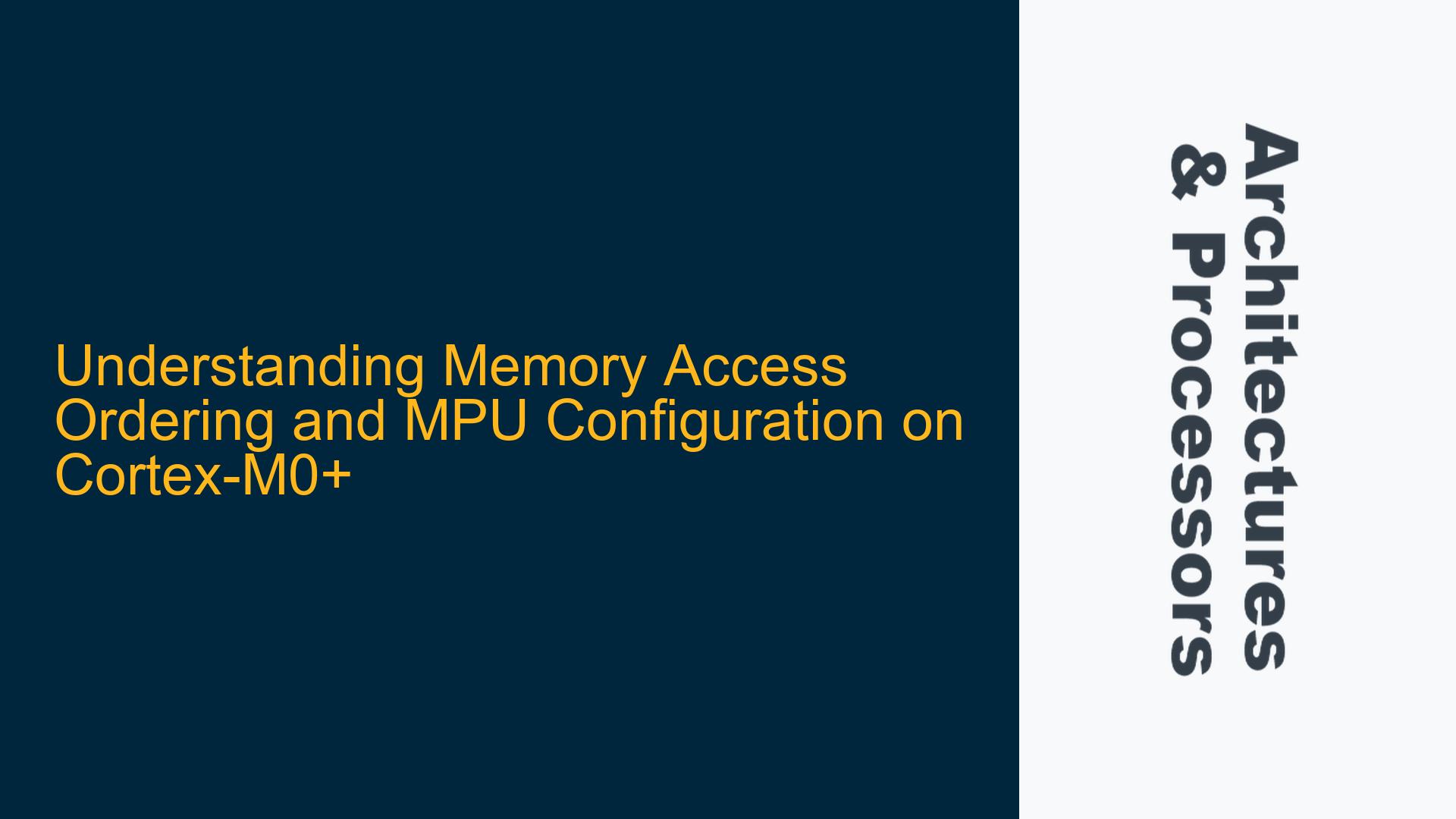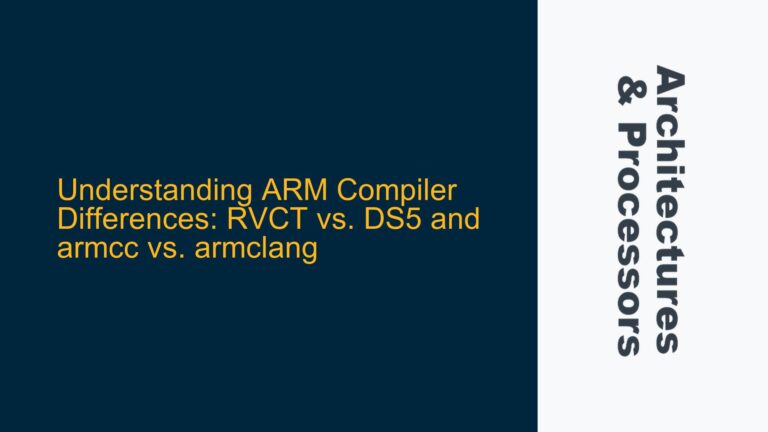Memory Access Ordering in Cortex-M0+: Normal vs. Device Memory Attributes
The Cortex-M0+ processor, like other ARM Cortex-M series processors, employs a memory system that differentiates between Normal memory and Device memory. This distinction is critical for understanding how the processor handles memory transactions, particularly in terms of ordering and speculative accesses. Normal memory allows the processor to reorder transactions for efficiency and perform speculative reads, which can significantly improve performance in typical embedded applications. However, this reordering can lead to unintended side effects when accessing memory-mapped peripherals, which often require strict transaction ordering to ensure correct operation.
Device memory, on the other hand, enforces strict ordering of memory transactions. This means that the processor will not reorder transactions to Device memory relative to other transactions to Device or Strongly-ordered memory. This is crucial for peripheral registers, where the order of read and write operations can directly impact the behavior of the hardware. For example, writing to a control register before a data register might be necessary to configure the peripheral correctly, and reordering these writes could lead to incorrect operation.
The default memory map for Cortex-M0+ processors typically assigns Normal memory attributes to regions like SRAM (e.g., 0x2000_0000). However, if a peripheral register is mapped to this region, the default Normal memory attributes may not be appropriate. The Memory Protection Unit (MPU) can be used to override these default attributes and assign Device memory attributes to specific regions. This ensures that transactions to peripheral registers are handled with the required ordering guarantees.
Impact of MPU Configuration on Memory Access Ordering
The MPU in Cortex-M0+ processors provides a mechanism to define memory regions and assign specific attributes to those regions. These attributes include memory type (Normal, Device, or Strongly-ordered), access permissions, and other properties. When the MPU is configured to change the memory type of a region from Normal to Device, it directly affects how the processor handles memory transactions to that region.
For example, consider a peripheral register mapped to the address 0x2000_0000, which is in a region that defaults to Normal memory. If the MPU is not configured to change the memory type to Device, the processor may reorder transactions to this address, leading to potential issues with peripheral operation. By configuring the MPU to assign Device memory attributes to this region, the processor will enforce strict ordering of transactions, ensuring that writes and reads to the peripheral registers occur in the expected sequence.
It is important to note that the MPU configuration does not affect the physical memory or the hardware itself; it only changes how the processor interacts with the memory. This means that the MPU can be used to enforce correct memory access ordering without modifying the underlying hardware design. However, the MPU configuration must be carefully designed to avoid conflicts or unintended side effects, particularly in systems with multiple memory regions and peripherals.
Configuring the MPU for Correct Memory Access Ordering
To ensure correct memory access ordering for peripheral registers on Cortex-M0+ processors, the MPU must be configured to assign Device memory attributes to the relevant memory regions. This involves defining the memory region, setting the appropriate attributes, and enabling the MPU. The following steps outline the process:
-
Define the Memory Region: Identify the memory address range that contains the peripheral registers. For example, if the peripheral registers are mapped to addresses 0x2000_0000 to 0x2000_0FFF, this range should be defined as a memory region in the MPU.
-
Set the Memory Attributes: Configure the memory attributes for the defined region. Set the memory type to Device to enforce strict ordering of transactions. Additionally, set the access permissions to ensure that the processor can read and write to the peripheral registers as required.
-
Enable the MPU: Once the memory region and attributes are configured, enable the MPU to apply the new settings. This ensures that the processor enforces the specified memory attributes for all transactions to the defined region.
-
Verify the Configuration: After enabling the MPU, verify that the memory access ordering is correct by testing the peripheral operation. This may involve writing to and reading from the peripheral registers in a specific sequence and checking that the results are as expected.
By following these steps, developers can ensure that the Cortex-M0+ processor handles memory transactions to peripheral registers with the required ordering guarantees. This is particularly important in systems where the correct operation of peripherals depends on the precise sequence of memory accesses.
Addressing Common Pitfalls in MPU Configuration
While configuring the MPU to enforce correct memory access ordering is straightforward, there are several common pitfalls that developers should be aware of:
-
Overlapping Memory Regions: If multiple memory regions overlap, the MPU may apply conflicting attributes, leading to undefined behavior. Ensure that memory regions are defined with non-overlapping address ranges.
-
Incorrect Attribute Settings: Setting the wrong memory attributes can lead to incorrect memory access ordering or access violations. Double-check the memory type and access permissions when configuring the MPU.
-
MPU Disabled or Misconfigured: If the MPU is not enabled or is misconfigured, the processor will use the default memory attributes, which may not be appropriate for peripheral registers. Always verify that the MPU is enabled and configured correctly.
-
Performance Impact: Enforcing strict ordering of memory transactions can impact performance, particularly in systems with high memory bandwidth requirements. Consider the trade-offs between performance and correct operation when configuring the MPU.
By addressing these pitfalls, developers can ensure that the MPU configuration effectively enforces correct memory access ordering without introducing new issues.
Practical Example: Configuring the MPU for a UART Peripheral
To illustrate the process of configuring the MPU for correct memory access ordering, consider a practical example involving a UART peripheral. The UART peripheral is mapped to addresses 0x4000_0000 to 0x4000_0FFF, and the default memory attributes for this region are Normal. To ensure correct operation, the MPU must be configured to assign Device memory attributes to this region.
-
Define the Memory Region: Define a memory region in the MPU for the address range 0x4000_0000 to 0x4000_0FFF.
-
Set the Memory Attributes: Set the memory type to Device and configure the access permissions to allow read and write access.
-
Enable the MPU: Enable the MPU to apply the new memory attributes.
-
Verify the Configuration: Test the UART peripheral by sending and receiving data. Verify that the data is transmitted and received correctly, indicating that the memory access ordering is correct.
By following these steps, developers can ensure that the UART peripheral operates correctly, with the required memory access ordering enforced by the MPU.
Conclusion
Understanding and configuring memory access ordering on Cortex-M0+ processors is essential for ensuring the correct operation of embedded systems, particularly when accessing memory-mapped peripherals. By using the MPU to assign Device memory attributes to peripheral regions, developers can enforce strict ordering of memory transactions, preventing issues caused by reordering or speculative accesses. Careful configuration of the MPU, along with thorough testing, can help avoid common pitfalls and ensure reliable system operation.






